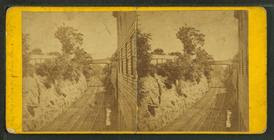Our brains combine these two different eye-images into one, a pheno- menon that enables us to "see" ever so slightly, around the sides of objects, providing spatial depth and dimension. Stereoscopic views consist of two nearly twin photographs, one for the left eye, one for the right eye. Viewing the side-by-side images through a special lens arrangement called a stereoscope helps our brains combine the two flat images and "see" the illusion of objects in spatial depth. Photographers around the world produced millions of stereoscopic views between 1850 and 1930. The main reason for the over abundance of views was the fact that Queen Victoria and Prince Albert received the gift of a stereoscopic viewer at the Crystal Palace exhibition in 1851. Wasn't long before American jurist Oliver Wendell Holmes called for the establishment of "special stenographic collections just as we have professional and other libraries." Most everyone bought a stereoscope and began to take photos. Local history, current events, portraitures, architecture, disasters and even war were documented. By the 1890s leading publishers such as Underwood & Underwood as well as the Keystone Company produced topical and documentary series covering landscape, travel and the growth of cities. One of the most prolific photographers of stereoscopic images was Robert N. Dennis who lived between 1900 and 1983. In 1939 he had an exhibit in New York City for the 100th Anniversary of photography's discovery that featured stereographs from his collection. Then, New York Public Librarian Sylvester Vigilante, suggested the Library purchase Mr. Dennis' entire collection, which they did. With the $5,000 Mr. Dennis bought his wife a fur coat and moved from Brooklyn to the northern suburb of Pelham. Today, if you happen to see a stereoscope photograph, turn it over and see if "Robert Dennis Collection/N.Y.P.L. might be on it. As I read more about Mr. Dennis, I found a sizable amount of his stereoscope images online of my hometown of Lancaster, Pennsylvania. If you ever visit a flea market or antique store, check out the photo stands and see if they might have any stereoscopic prints. Examine the rear to see if they might have been made by Mr. Robert Dennis. May want to purchase one to say you have a part of photographic history. And, if you can find a stereoscope, place it in the holder and check out the 3D image that results. One of my regrets of selling my entire photographic collection was getting rid of my stereoscope and the dozen or so steroscopic photos I had. None where from the famous Mr. Robert Dennis, but they were still interesting to view in the stereoscopic unit. It was another extraordinary day in the life of an ordinary
 |
| Conestoga River at 2nd Lock - Click on images to enlarge them. |
 |
| Conestoga River at 1st Lock |
 |
| East King Street on Market Day |
 |
| Fulton Hall aka Fulton Opera House |
 |
| Lancaster Crematorium |
 |
| Liiden Hall School for Girls |
 |
| Lititz Springs Park |
 |
| North Queen Street |
 |
| Lancaster's Penn Square |
 |
| Presbyterian Church |
 |
| Lancaster County Prison |
 |
| Railroad tracks south of Lancaster |
 |
| Houses of West Lancaster |
 |
| Woodward Cemetery |


No comments:
Post a Comment